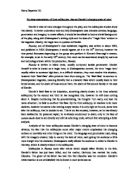Then you look at the second soliloquy and you begin to notice that he is more aware about the things he is saying as this soliloquy is much calmer and more structured and an example of this is again the use of exclamation marks and in this soliloquy there are none used in spite or anger. You also realise that it is calm as the soliloquy allows you time to breath as Shakespeare uses commas and full stops.
The first soliloquy is about Hamlets hatred for the marriage of his mum and uncle shortly after the death of his father and he emphasises his hatred of their marriage throughout the soliloquy. The second soliloquy is about suicide and fighting back against everyone. It’s also about Hamlet deciding whether or not to kill his uncle Claudius. In the second soliloquy he consistently talks about life after death and in the first soliloquy Hamlet says that people are too scared to kill themselves, as they believe they will go to hell. Nobody knows what life after death is as no one has ever come back to tell their story. Revenge tragedy stories usually contain suicides and early deaths, which at the end of the play involve someone taking revenge on another character. Revenge tragedies were taken from Greek and Roman playwrights and since then have been very successful. Many of Shakespeare’s plays have contained revenge tragedy stories. The use of repetition of words in the soliloquies increases our understanding of the soliloquies and I know this as Shakespeare used repetition in his plays to express anger and confusion. “O’fie!” And the reason for his anger is because of all the events, which have taken place recently e.g. the remarriage of his mother.
Shakespeare also uses some rhythm in the second soliloquy and none in the first and he does this to show a lot of confusion in act one scene two and then uses rhythm to show Hamlets confidence evolve and it shows he has thoroughly thought things through.
Shakespeare creates a lot of images in the first soliloquy. “O, that this solid flesh ….” When hamlet is contemplating suicide, this tells us Hamlet is very unhappy with his life, he comments “How weary, stale, flat and unprofitable seems to me all the uses of this world!” Hamlet is asking why? Why are we put on this world? He then goes onto say “Tis an unweeded garden that grows to seed; things rank and gross in nature possess it merely.” Hamlet describes to us how he must look after our world and like wise his life.
Lines 10-14 Hamlet is speaking about his father “But two months dead! Nay, not so much, not two.” Not even two months and Hamlets mother has remarried and this results in Hamlet becoming even more confused “Would have mourned longer – married with my uncle.” Hamlet is asking himself why his mother hasn’t mourned for longer.
Hamlet then compares his father to a sun god “Hyperion” Who is half goat and half man “So excellent a king, that was, to this.” Here Hamlet is speaking about his father being a great king to his country. Whereas throughout the soliloquy he talks bad of his mother, Hamlet is confused about how his mother could remarry so soon after his father’s death not only that but she remarried to Hamlets uncle Claudius, Hamlet feels betrayed. He feels this is incest and seeing his mother marry his uncle has broken his heart. “With such dexterity to incestuous sheets! But break, my heart, for I must hold my tongue.”
The purpose of a soliloquy is to show a characters innermost thoughts and feelings during the play. Soliloquies are performed by characters that express their feelings and beliefs on another character or event in the play as they are merely talking to the audience and not having to conceal their beliefs in front of another character, which may cause them to withhold their true opinions. Therefore, Hamlets first speech in act one scene two is essential to the understanding of his actions throughout the play. This is because it reveals his true opinions about the promptness of his mother’s wedlock to his uncle and Hamlets decision to murder his uncle.
In the first soliloquy Shakespeare shows us Hamlets confusion to the death of his father and the remarriage of his mother by using repetition, such as; “too, too” and “fie on’t! O’fie!” and this also represents Hamlets disgust to his mothers decision. Hamlet also becomes very angry and talks about the hierarchy and labels Claudius to be one of the lowest living organisms that exists.
However in the second soliloquy Shakespeare doesn’t use repetition and this shows Hamlet growing in confidence and he is becoming to understand the way of life “seem to me all the uses of this world!”
Shakespeare also cleverly evolves Hamlets character during the two soliloquies and he does this through the perception you get of Hamlet as he begins the first soliloquy as a very confused and unpleasant person whereas in the second soliloquy Hamlet comes across as being very open minded and confident. He then ends the second soliloquy by speaking about mankind and not just himself and that shows that he has moved on and that there are a lot of things going wrong in the world and there are other people with as equally harsh issues as Hamlet has gone through.
In conclusion Hamlets character evolves through the soliloquies and Shakespeare has made this blatant to the audience and the soliloquies have worked very effectively as they broke up Hamlets thoughts into sections for the audience to give them a clearer understanding of his actions throughout the play.
By Nathan Truckle.







